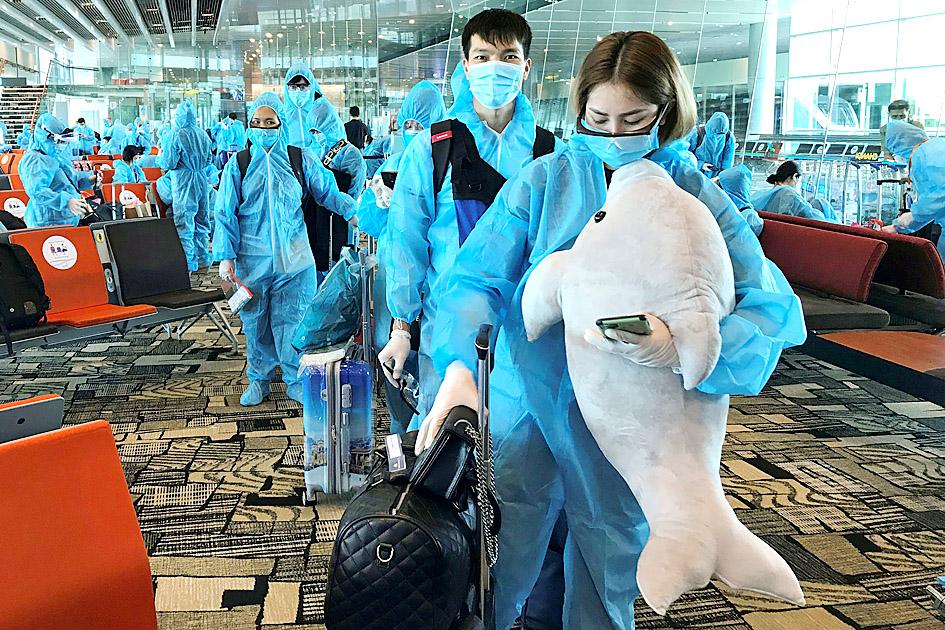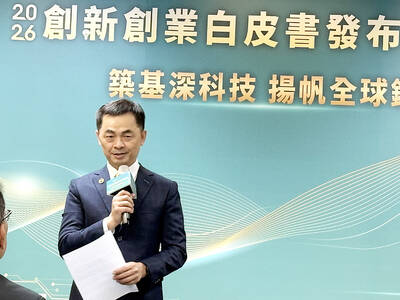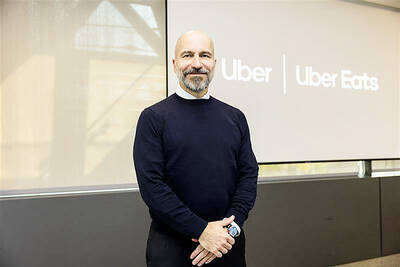The cost of air tickets between two major Asian financial hubs jumped within 24 hours of Singapore and Hong Kong unveiling plans for a travel bubble that would not require people to quarantine upon arrival.
The cheapest price for a Singapore Airlines Ltd return economy seat to Hong Kong yesterday morning was S$558 (US$410) up until the end of December, versus around S$400 Thursday afternoon as the news was announced, the airline’s website showed. Return business-class fares rose about HK$5,000 (US$645) to HK$19,000. Cheaper flights were still available on travel Web sites including Skyscanner Ltd.
The COVID-19 pandemic has hit the flag carriers of Singapore and Hong Kong especially hard as they do not have any domestic market to fall back on. Prior to the pandemic, around 1 million trips were made between the two regional centers every year, data from the Singapore and Hong Kong tourism boards showed.

Photo: Reuters
Hong Kong-listed Cathay Pacific Airways Ltd closed up 6.1 percent on Thursday and yesterday rose as much as 6.4 percent as investors digested the news. The agreement could lift Cathay’s monthly revenue by HK$90 million and reduce cash burn by as much as 6 percent, said Bloomberg Intelligence analysts James Teo and Chris Muckensturm, who assume revenue on the Hong Kong to Singapore route amounted to about 3 percent of Cathay’s total pre-pandemic.
Singapore Airlines, which yesterday rose as much as 1.4 percent, could see a S$15 million boost to monthly revenue and 6 percent reduction in cash burn, Teo and Muckensturm said. The route also made up about 3 percent of its revenue before COVID-19, they said.
The number of flights between Hong Kong and Singapore slumped, with only 54 round trips filed this month, down 90 percent from a year earlier, aviation analytics company Cirium said.
“Although the travel bubble will potentially facilitate increase of services by Cathay Pacific, Singapore and Scoot, who have continued to operate minimal services on the route through 2020, demand is expected to remain depressed in the near-term as passenger confidence remains low,” said Herman Tse, an analyst at Cirium.
Still, the bubble plan has encouraged some to book flights or make plans to travel. Singapore-based Clarence Foo, who works for APAC Realty Ltd unit ERA, said that four Chinese with Hong Kong residency had told him that they planned to fly down to the city-state and purchase luxury apartments.
“They’re constantly asking about the property market — whether it’s recovering and whether prices are coming up,” Foo said. “Some had planned to come down earlier in the year, but then Singapore imposed border controls. They know that the city’s property market seems to be more resilient now as there have been more sales and prices are low, so they want to capitalize on that.”
Under the travel bubble, compulsory quarantine would be replaced by COVID-19 testing. Singaporean Minister of Transport Ong Ye Kung (王乙康) said he hopes that the bubble would start in “weeks.” Other details of the agreement would be fleshed out later, the Hong Kong government said, without giving any date for when the plan would come into effect.
Singaporean Victoria Ho used to travel from Hong Kong back home to Singapore every month. After a hiatus, she is back on a plane this weekend. Although the bubble has not kicked in, she welcomed the announcement, saying it would allow friends to visit.
“I’ll be able to pop home to meet with coworkers and clients, because I do have meetings I’d like to make there,” she said.
Tan Wei Lynn, who works in the financial sector in Hong Kong, booked her ticket to Singapore soon after the announcement. She plans to stay for several weeks and not fly back to Hong Kong until December, assuming that there would be more details laid out by then.
“Having to quarantine is what’s stopped me, and a lot of people I know, from traveling,” Tan said. “Yes, tests are expensive, but it’s not about the cost of testing. We can’t afford to quarantine at one side or both sides.”

CHIP RACE: Three years of overbroad export controls drove foreign competitors to pursue their own AI chips, and ‘cost US taxpayers billions of dollars,’ Nvidia said China has figured out the US strategy for allowing it to buy Nvidia Corp’s H200s and is rejecting the artificial intelligence (AI) chip in favor of domestically developed semiconductors, White House AI adviser David Sacks said, citing news reports. US President Donald Trump on Monday said that he would allow shipments of Nvidia’s H200 chips to China, part of an administration effort backed by Sacks to challenge Chinese tech champions such as Huawei Technologies Co (華為) by bringing US competition to their home market. On Friday, Sacks signaled that he was uncertain about whether that approach would work. “They’re rejecting our chips,” Sacks

NATIONAL SECURITY: Intel’s testing of ACM tools despite US government control ‘highlights egregious gaps in US technology protection policies,’ a former official said Chipmaker Intel Corp has tested chipmaking tools this year from a toolmaker with deep roots in China and two overseas units that were targeted by US sanctions, according to two sources with direct knowledge of the matter. Intel, which fended off calls for its CEO’s resignation from US President Donald Trump in August over his alleged ties to China, got the tools from ACM Research Inc, a Fremont, California-based producer of chipmaking equipment. Two of ACM’s units, based in Shanghai and South Korea, were among a number of firms barred last year from receiving US technology over claims they have

BARRIERS: Gudeng’s chairman said it was unlikely that the US could replicate Taiwan’s science parks in Arizona, given its strict immigration policies and cultural differences Gudeng Precision Industrial Co (家登), which supplies wafer pods to the world’s major semiconductor firms, yesterday said it is in no rush to set up production in the US due to high costs. The company supplies its customers through a warehouse in Arizona jointly operated by TSS Holdings Ltd (德鑫控股), a joint holding of Gudeng and 17 Taiwanese firms in the semiconductor supply chain, including specialty plastic compounds producer Nytex Composites Co (耐特) and automated material handling system supplier Symtek Automation Asia Co (迅得). While the company has long been exploring the feasibility of setting up production in the US to address

OPTION: Uber said it could provide higher pay for batch trips, if incentives for batching is not removed entirely, as the latter would force it to pass on the costs to consumers Uber Technologies Inc yesterday warned that proposed restrictions on batching orders and minimum wages could prompt a NT$20 delivery fee increase in Taiwan, as lower efficiency would drive up costs. Uber CEO Dara Khosrowshahi made the remarks yesterday during his visit to Taiwan. He is on a multileg trip to the region, which includes stops in South Korea and Japan. His visit coincided the release last month of the Ministry of Labor’s draft bill on the delivery sector, which aims to safeguard delivery workers’ rights and improve their welfare. The ministry set the minimum pay for local food delivery drivers at